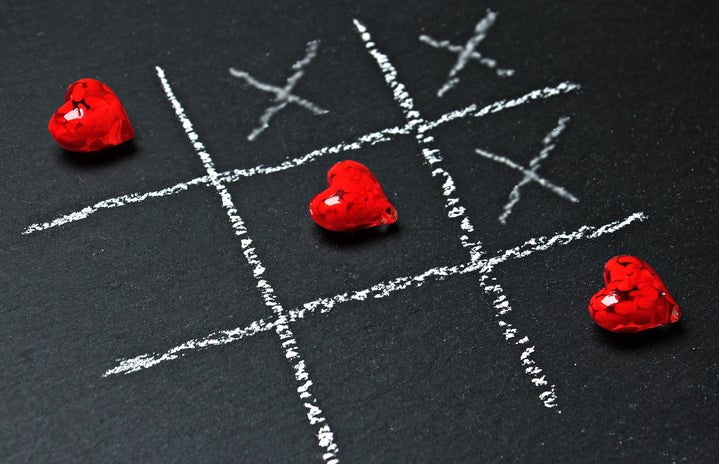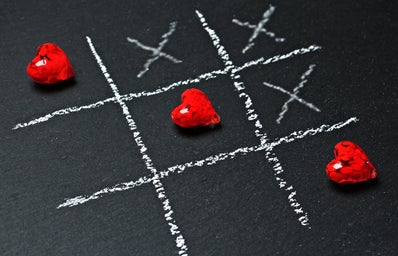Going to an all-women’s college came easily to me. My sister attended Wellesley and my father teaches at a women’s college, so I wasn’t at all daunted by Mount Holyoke College’s strongly gendered student body. In fact, I embraced it. To me, not having boys around meant I could roll out of bed five minutes before class, forego all make-up, and basically not worry about maintaining my feminine mystique. It turns out, however that not everyone at Mount Holyoke embraced the absence of men in the same way I did.
Bisexuality has been downplayed for years. I’ve heard bisexual people criticized for having “two hands in the cookie jar”, or just plain old being greedy when it comes to sex and lovers. In the past, bisexuality was even considered just to be a short detour on the way to full-blow homosexuality – a joyride somewhere between straight and gay. It was only in early 2008 that psychologist Lisa Diamond published the results of a study that shows bisexuality in women is a legitimate sexual identity. She followed 70 non-heterosexual women for a decade, and stated that her research proved that female sexuality is fluid. The research found that these women did honestly enjoy both sexes and their identity truly was “bisexual”.
As far as Mount Holyoke women and many other ladies are concerned, Lisa Diamond may be right in her conclusion – or at least that’s how it seems here on campus. But after spending two full years on campus, taking in the scene and watching girls break up with boyfriends, then chop off their hair and make out with a girl at a party, I find it far more likely that at least for some, bisexuality is truly just a phase.
Samina: The Full-Blown Lesbian
Samina Dhar was gay when she arrived at Mount Holyoke. “It’s one of the reasons I chose to come here!” she says. She adores the college, but especially appreciates seeing women test their sexual boundaries and try out new things.
“I remember the first time I even thought about liking girls”, she says, laughing. She tells me about falling in love with her best friend in middle school and denying all the urges she felt to act on her feelings all the way into high school. Then one night at a party, she kissed her friend, and although the girl felt differently than Samina, it was a life-changing moment. “So she wasn’t feeling it, but after that, I knew I was gay. And I didn’t know what I’d been so worried about all along. I was so mad that I wasted time kissing boys!”
Samina admits coming out was scary, and she walked the bisexual line for a while, easing her way into Lesbian Land. “I sort of used ‘bi’ as a way to transition into being gay – it was easier for people to handle it that way, and easier for me to adjust.” She thinks a lot of girls at Mount Holyoke are doing the same, but agrees that there are definitely some who are just following the crowd, which doesn’t bother her in the slightest. “I’ve hooked up with girls here who have boyfriends at home and are exploring bisexuality as a way to get some without pissing off their guy,” she says. For people like that, it’s probably just a phase. But for others, like Samina, bi is just a pit stop on the way to gay.
Katie: The Typical Straight Girl on Campus
“It’s definitely convenient to be bisexual while you’re here,” says junior Katie Sullivan. Katie is straight, and always has been. She’s a junior at Mount Holyoke and although she’s witnessed several friends of hers evolve from straight to gay, she doesn’t think it’s something she’ll do. Still, she says she can see the appeal. “The women on campus who are gay are typically the people that everyone knows and like, and they’re also the ones getting the best experience here,” says Katie. The BDOCs (Big Dykes on Campus) tend to have a wider social network because they all party together, invite more gay girls on campus, date, party, break up, party, date, etc. “Their social circle gets bigger each week – mine gets smaller because I don’t want to go to an all-girl party. No one’s turning straight here and hanging out with us. People just become gay and move into that world.”
It’s easy to see where Katie’s coming from. She’s a pretty brunette but she may as well have “STRAIGHT” written across her forehead. She has a good amount of friends as Mount Holyoke, but she can’t relate to them all like she can relate to her straight friends. “I’ve considered hooking up with a girl,” she laughs, “and maybe I will. I mean, I admit that I’ve kissed a girl, but dated one? Not yet. But who knows? Everyone here makes it look fun, anyways.” I know she’s kidding, but I also know she’s probably considered it.
Daria: The Convert on Campus
Katie has a point – bisexuality is convenient. And I’m sure it’s fun! The girl sitting next to you in class could be your next love affair, and odds are you have a lot in common with her. Plus, you can share clothes. So yes, there are obvious benefits to being bi. But it’s not all sunshine and rainbows, says senior Daria Kurtz. “Women’s colleges are small,” she says, “so everyone knows your business. If you hook up with someone, everyone knows, and if you break up with someone, everyone knows. It can be a lot of drama, and there’s no way to escape it.” When asked if she identifies as gay or bi, and what gender she see herself pursuing in the future, Daria isn’t sure. She shoots me a look and a sly smile: “I like girls. I do. But after four years of this, a hot guy wouldn’t be a bad thing.”
Daria came here as a straight woman who had wondered about her sexuality before, but not too seriously. But upon her arrival at Mount Holyoke, she began to wonder again, actually considering bisexuality as an option this time. Soon she was going to parties to meet girls, hooking up with them, dating them, breaking up with them, and then making up with them – just like she had been doing with high school boyfriends. “It’s the same, but it’s so different, too,” Daria says. “It’s like, when does it stop being friendship and start being a relationship? Because this girl can be my best friend, but she’s also who I’m sleeping with. And you don’t sleep with your best friends, right? Or you shouldn’t, probably.”
For Daria, Mount Holyoke was an opportunity to explore a part of herself that she felt she couldn’t show in the “real world”. She had always been bi, but she’d been suppressing it. Psychologist William Wedin, director of New York City’s Bisexual Information and Counseling Service says, “part of being bisexual means that you see things from more than one perspective. You can’t be comfortable in stereotypical ways of thinking and reacting.” Daria believes that describes her perfectly. “Those are also the reasons I ended up at Mount Holyoke – I think differently.” In that case, it makes sense that so many women at women’s colleges identify as bi.It’s a warm, supportive environment that is conducive to experimentation, and it includes a lot of open-minded, intelligent women. It’s a great thing! Although Daria is happy to have accepted her bisexuality, she doesn’t think she’ll ever identify as gay. “I see myself with a man,” she says. “Twenty years from now, I won’t be dating girls. I’ll be in a serious relationship with a guy, hopefully.” To her, being bi-curious is fun, but not something she plans to act on as an adult.
Is Bi Taking Over?
The moral of the story is that our sexual identity is entirely our own. No matter what studies emerge and categorize people or legitimize orientations, we are who we are. Homosexuality existed long before anyone chose to recognize it, and the same goes for bisexuality. Whether you are bi, bi-curious, or just drunk and kissing your friend for kicks, that’s just who you are and it’s totally cool.
It’s clear from real world experience as well as research that women are more open to the idea of sexual experimentation than men are. In 2005, a group of psychologists in Chicago performed a study that showed most bisexual men were really only aroused by other men – in other words, most bi men are actually gay. And of course, at any frat party the occasional cries of “NO HOMO!” can be heard resounding through the room. But women are different, it seems, which is why Lisa Diamond chose women for her sexuality study. We are sexual creatures, and that’s awesome. Whether we are straight, BUGS, LUGS, or gay, we should be open to questioning ourselves and trying new things if we feel so inclined. College is the time to learn who you are and test new waters, and if that means a one-night stand with the butch girl down the hall, then go for it.
Sources:
Samina Dhar, Mount Holyoke College senior
Katie Sullivan, Mount Holyoke College junior
Daria Kurtz, Mount Holyoke College junior
USA Today – http://www.usatoday.com/news/health/2008-01-15-bisexual-women_N.htm
Lisa Diamond- http://www.narth.com/docs/diamond.html ; http://www.psych.utah.edu/people/person.php?id=54
http://www.time.com/time/magazine/article/0,9171,976240-4,00.html

